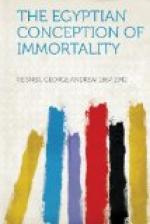To gain some idea of the way in which these two conceptions of the living dead were worked out in actual life, one has only to turn to the funerary customs of the modern Egyptians. In the case of both Christians and Moslems, the grave rites are similar; but with those of the Moslems I am more familiar. The grave consists still of the two parts, the burying place and the offering place. The swathed body is laid on the right side, with the right hand under the cheek and the face towards Mecca. At the burial the confession of the faith is recited over and over, lest the dead forget it.
Korans are sometimes placed in the graves; and I have even seen a confession of the faith written on paper and placed on a twig before the face of the dead. At the appointed seasons— especially at the great Feast of Sacrifice—offerings are brought to the grave. The family party passes through the cemetery, the women bearing baskets of bread and bottles of water, the men turning the head to the right and to the left and reciting the fatha in propitiation of the spirits. The party enters the offering inclosure of the grave of their relative. The wives greet the dead—“Peace unto thee, oh, my husband, oh, my father, we have wept until we have watered the earth with our tears on thy account.” The offerings are laid before the tomb. A scribe is called and recites or reads some chapter of the Koran over and over, one hundred, one hundred and fifty, five hundred, one thousand times, and concludes: “I have read this for thee, oh, such and such a one.” Or, “I have transferred the merit of this to thee.” When you question these people as to the particulars of their belief, you find their ideas vague and indefinite. Among the men a dispute quickly starts,—the people who have been found good by the examining angels on the night of the burial are there, but the bad are somewhere else. No, says another, they are all in their graves, but the bad suffer torment. Still another maintains that the good have already passed to the lowest heaven. These are all mere remnants of theological discussions caught from the sheikhs. The women stolidly maintain that the dead are in their tombs and the offerings must be brought. When you inquire which are the good and which are the bad, there is again a great divergence of opinion; but it is clear that every man believes in his heart that a knowledge of the prayers and forms of the Moslem religion is absolutely essential and entirely sufficient to gain a desirable future life. The great master word is the confession of faith—there is no god but Allah and Mohammed is his prophet.
So it must have been in the last stage of the Osiris cult. Immortality, a glorified future existence as an Osiris in the kingdom of Osiris, with all the pleasures and comforts of life, was secured to him who was buried with the proper rites and knew the magic words. And yet the old feeling was never lost that the dead was somehow in the grave and might suffer hunger and thirst.




